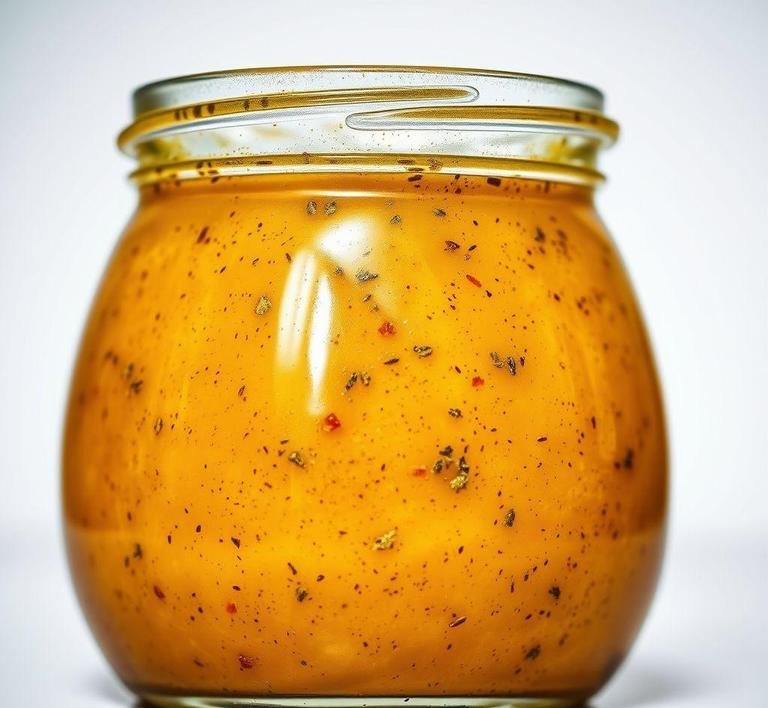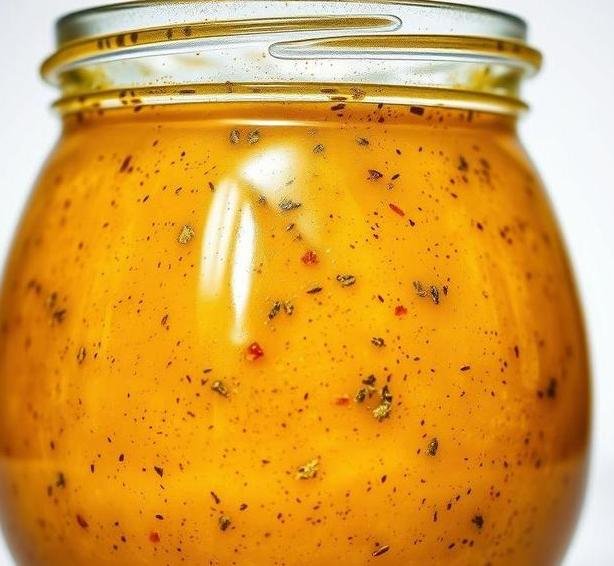Mary Berry’s French Dressing is a delightful, zesty vinaigrette that brings simplicity and elegance to your salads and cold dishes. Known for her no-fuss, fail-proof recipes, Mary Berry has created a dressing that balances sharpness, sweetness, and depth with astonishing grace. This dressing is a variation of the classic French vinaigrette but with Mary’s trademark British twist: it’s smoother, slightly sweeter, and incredibly versatile.
Unlike heavier creamy dressings, this one is oil-based, meaning it’s lighter and allows the flavors of fresh vegetables to shine through while enhancing them with a tangy, aromatic kick. It’s a staple in Mary’s home kitchen and features frequently in her recipes and cookbooks-because it’s just that good. Whether you’re dressing a crisp green salad, drizzling it over roasted vegetables, or using it to marinate chicken, this dressing adds instant sophistication.
Mary Berry’s French Dressing Recipe
Ingredients Needed

Mary Berry’s version of French Dressing typically includes the following ingredients, all easily found in your pantry or local supermarket:
- Olive oil – The backbone of the dressing, providing body and a smooth mouthfeel. Mary prefers a light olive oil so it doesn’t overpower.
- White wine vinegar – Adds a gentle acidity that brightens the dressing without being too sharp.
- Dijon mustard – For that distinct French zing and creamy texture. It also helps emulsify the dressing.
- Lemon juice – Brings a fresh, citrusy brightness that pairs beautifully with green leaves.
- Caster sugar – Just a touch balances the tartness and rounds out the flavor.
- Salt and black pepper – Essential for seasoning and enhancing the taste of every component.
- Optional: Garlic or shallots – For a bolder, aromatic profile (Mary sometimes adds these when she wants extra punch).
These ingredients work in harmony to create a balanced dressing-tangy, slightly sweet, with a subtle depth from the mustard and vinegar.
Equipment Needed
You really don’t need fancy tools to make Mary Berry’s French Dressing, and that’s part of its charm. Here’s what you’ll need:
- Measuring spoons and cups – Accuracy matters in achieving that perfect balance.
- Small mixing bowl or jug – Preferably with a spout for easy pouring.
- Whisk or fork – To emulsify the dressing by combining the oil and vinegar mixture thoroughly.
- Glass jar with lid (optional) – Ideal if you prefer the shake-and-store method. It also lets the flavors meld over time.
- Citrus juicer (optional) – For squeezing fresh lemon juice with minimal effort.
That’s it! No blender or food processor necessary-this is as approachable as it gets.
Instructions To Make Mary Berry’s French Dressing
Making this dressing is delightfully simple and takes less than 5 minutes. Here’s a step-by-step breakdown to help you master it:
1. Combine The Base
In a small bowl or jug, pour in the olive oil, white wine vinegar, and fresh lemon juice. These three form the liquid backbone of the dressing.
2. Add The Emulsifiers And Flavor Enhancers
Whisk in the Dijon mustard and caster sugar. This is where the magic begins. The mustard helps emulsify the oil and vinegar, giving the dressing a creamy texture, while the sugar adds a hint of sweetness that makes the flavor pop.
3. Season Well
Add a generous pinch of salt and freshly ground black pepper. Taste as you go-this is key to personalizing the dressing to your palate.
4. Whisk It All Together
Use a whisk or fork to combine all the ingredients until the mixture is silky and emulsified. If you’re using a jar, you can just shake everything vigorously for about 30 seconds.
5. Taste And Adjust
This is the fun part-taste your dressing. Want it tangier? Add more vinegar or lemon. Too sharp? A pinch more sugar. Tailor it to your liking.
6. Serve Or Store
Drizzle immediately over salads or store in the fridge in a sealed jar. It keeps well for up to a week-just give it a good shake before using again.
Tips And Tricks
Mary Berry’s style is all about elegance made simple, and her dressing reflects that. Here are some insider tips to make it truly shine:
- Use high-quality olive oil – It’s the main component, so the better the oil, the more flavorful your dressing.
- Balance is key – Always taste and adjust. A bit more lemon or sugar can transform the final result.
- Add herbs for variation – Fresh tarragon, chives, or parsley can elevate this dressing for specific dishes.
- Make it in advance – Letting it sit for a few hours allows the flavors to meld beautifully.
- Use it as a marinade – It’s not just for salads. This dressing is lovely on grilled vegetables, chicken, or even fish.
- Double the batch – It stores beautifully and you’ll find yourself reaching for it throughout the week.
Mary Berry’s French Dressing is a masterclass in simplicity and flavor. It’s a quick-to-make, beautifully balanced vinaigrette that elevates everyday meals into something special. Whether you’re a salad aficionado or just someone looking to jazz up weeknight dinners, this dressing is a must-have in your culinary arsenal.
With just a few pantry staples and a couple of minutes, you can capture the essence of Mary Berry’s refined yet approachable style right in your own kitchen. So next time you toss a salad, drizzle a roast, or prepare a summer spread, do it with a touch of Mary’s magic.
Easy Recipe Variations For Mary Berry’s French Dressing

Mary Berry’s French dressing is a beautifully balanced vinaigrette – tangy, slightly sweet, and deeply savory with just the right touch of Dijon mustard. It’s the kind of dressing that adds polish to a humble salad and elevates simple ingredients into something restaurant-worthy. But what if you’re in the mood to switch things up a little? The good news is, this dressing is incredibly versatile and lends itself to some delightful variations:
1. Honey Mustard Twist
Add a tablespoon of honey to the original dressing recipe. This subtle tweak introduces a mellow sweetness that complements the mustard’s sharpness beautifully. Perfect for drizzling over grilled chicken salads or roasted root vegetables.
2. Herbed French Dressing
Herbs can completely change the flavor profile of the dressing. Try whisking in finely chopped fresh herbs like tarragon, parsley, chives, or basil. The herbs bring freshness and complexity that make this variation ideal for summer salads and grilled fish.
3. Creamy French Dressing
Want something a little richer? Stir in a tablespoon or two of Greek yogurt or sour cream. This creates a creamy, tangy version that clings to greens and veggies like a dream – particularly good on a wedge salad or with hearty leaves like kale or romaine.
4. Garlic & Lemon Zest Infusion
For a bolder, punchier dressing, add a minced garlic clove and a bit of lemon zest. The garlic adds depth while the zest gives it a clean, citrusy lift. This is lovely over lentil salads or as a marinade for grilled shrimp.
5. Balsamic Blend
Swap out some of the white wine vinegar for balsamic vinegar. The balsamic lends a deeper, almost fruity note that works wonderfully with roasted vegetables, goat cheese, or strawberries in a mixed salad.
Each of these variations is a simple twist on Mary’s original formula, yet they open up new dimensions of flavor and can be adapted to whatever you have in your fridge or pantry.
Storing Leftovers
Let’s talk storage – because a good dressing deserves to stick around for a few days (and make your weeknight dinners that much easier).
Refrigeration Is Key
Once you’ve made your French dressing, store it in an airtight jar or bottle and keep it in the refrigerator. It’ll typically last up to a week, although some people find it holds up even longer, especially if no fresh ingredients like herbs or garlic have been added.
Give It A Shake
Since oil and vinegar naturally separate over time, you’ll want to give the jar a vigorous shake before each use. If you notice any cloudiness or off smells, it’s best to discard it – vinaigrettes should be clear, vibrant, and fresh-smelling.
Creamy Or Yogurt-Based Versions
If you’ve gone with a creamy variation (like adding yogurt or mayonnaise), the shelf life is a bit shorter. Aim to use it within 3-5 days, and always store it in the coldest part of the fridge. The consistency may thicken over time, so feel free to thin it with a splash of water or lemon juice before serving.
What To Eat With Mary Berry’s French Dressing?
Oh, the possibilities! This dressing isn’t just for leafy greens (though it does shine there). Its versatility means you can pair it with a wide range of dishes and ingredients. Let’s explore some tasty pairings:
1. Classic Green Salad
Start simple. Toss crisp romaine, baby gem, or mixed spring greens with cherry tomatoes, cucumber, and red onion. The dressing ties everything together with its zippy, tangy flavor.
2. Warm Potato Salad
Skip the mayo! Dress warm baby potatoes with French dressing for a lighter, tangier twist. Add capers, chopped shallots, and parsley for extra punch.
3. Grilled Chicken Or Salmon
Drizzle the dressing over grilled meats or fish just before serving. It adds brightness and brings out the natural flavors, especially when you’ve used fresh herbs in the dressing.
4. Roasted Vegetables
Toss roasted carrots, bell peppers, or Brussels sprouts with the dressing while they’re still warm to help absorb the flavor. It’s a game-changer for your weekly meal prep.
5. Pasta Salads
Use the dressing as the base for a light pasta salad with arugula, sun-dried tomatoes, olives, and crumbled feta. The acidity cuts through the richness beautifully.
6. As A Marinade
Before grilling or roasting, marinate chicken breasts, tofu, or even mushrooms in the French dressing. The vinegar and mustard act as natural tenderizers, adding depth and complexity.
Whether you’re planning a picnic, a casual lunch, or a fancier dinner, Mary Berry’s French dressing fits right in. Its classic yet adaptable flavor makes it an essential tool in your flavor arsenal.
Conclusion
Mary Berry’s French dressing isn’t just a condiment – it’s a culinary chameleon. From the classic base recipe to creative twists involving herbs, honey, or creamy additions, this vinaigrette is endlessly adaptable. It’s a testament to how just a few simple ingredients – oil, vinegar, mustard, seasoning – can come together in perfect harmony and add that something special to a wide array of dishes.
Don’t forget: storing it properly extends its life and ensures you always have a jar of zesty, tangy flavor ready to go. And when it comes to what to eat it with? You’re limited only by your imagination (and maybe what’s in your fridge).
So whether you’re a seasoned home cook or a kitchen newbie looking to jazz up your meals, keep this French dressing in your rotation. After all, if it’s good enough for Mary Berry, it’s bound to be delicious.
FAQs
What Are The Ingredients For Mary Berry’s French Dressing Recipe?
Mary Berry’s French dressing recipe is simple and flavorful, requiring only a few basic ingredients: olive oil, white wine vinegar, Dijon mustard, caster sugar, salt, and pepper. These ingredients combine to create a tangy yet balanced dressing that’s perfect for salads, roasted vegetables, or even as a marinade.
How Can I Adjust The Sweetness Or Tanginess Of Mary Berry’s French Dressing?
To adjust the sweetness or tanginess of the French dressing, you can tweak the amount of sugar and vinegar. For a sweeter dressing, add more caster sugar, and for a tangier flavor, increase the white wine vinegar. Taste as you go to get the balance that suits your preferences. You can also experiment with other vinegars like red wine vinegar for a slightly different taste.
How Long Can I Store Mary Berry’s French Dressing, And Does It Need Refrigeration?
Mary Berry’s French dressing can be stored in an airtight container in the refrigerator for up to 1-2 weeks. The flavors will actually deepen over time, making it a great dressing to prepare in advance. Just make sure to give it a good shake or stir before using, as the ingredients may separate upon sitting.


